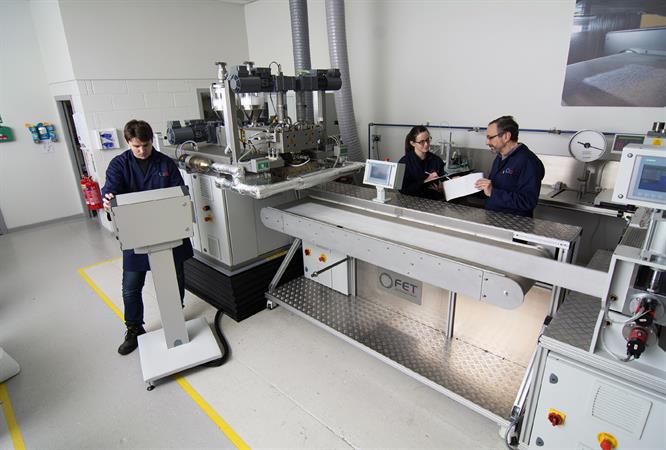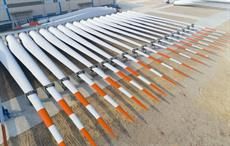Fibre Extrusion Technology (FET), UK-based specialist in process solutions and equipment for the manmade yarns and fibre extrusion industry, has received unprecedented enquiries about its nonwoven meltblowing systems since the onset of Coronavirus crisis. Meltblown polpropylene nonwovens are critical component of face masks needed for frontline workers.
Fibre Extrusion Technology (FET), UK-based specialist in process solutions and equipment for the manmade yarns and fibre extrusion industry, has received unprecedented enquiries about its nonwoven meltblowing systems since the onset of Coronavirus crisis. Meltblown polpropylene nonwovens are critical component of face masks needed for frontline workers.#
“We’re currently running trials, preparing samples and defining specifications for companies in Germany and Italy, as well as the UK, and we could already have sold the lab line we have here many times over,” managing director Richard Slack, said in a press release.
Fibre Extrusion Technology (FET), UK-based specialist in process solutions and equipment for the manmade yarns and fibre extrusion industry, has received unprecedented enquiries about its nonwoven meltblowing systems since the onset of Coronavirus crisis. Meltblown polpropylene nonwovens are critical component of face masks needed for frontline workers.#
It’s primarily designed for R&D and pilot scale applications, but trials have proven it to be suitable for the low volume production of critical meltblown face mask materials. Some of the customers to whom we’ve supplied similar lines have already pivoted their production to this, which has generated further interest.
Fibre Extrusion Technology (FET), UK-based specialist in process solutions and equipment for the manmade yarns and fibre extrusion industry, has received unprecedented enquiries about its nonwoven meltblowing systems since the onset of Coronavirus crisis. Meltblown polpropylene nonwovens are critical component of face masks needed for frontline workers.#
FET’s meltblown system was originally developed for companies looking to process high melt viscosity medical grade resorbable polymers such as PGA (polyglycolic acid), PLLA (polylactic acid) and PGH (polyhydroxl btyrate), mainly for use in implantable products and other medical devices. The key applications for these fibres are in hernia repair patches, staple reinforcement buttresses, artificial skin, adhesion barriers periodontal and ringival repair materials and those for tendon and ligament repair.
Fibre Extrusion Technology (FET), UK-based specialist in process solutions and equipment for the manmade yarns and fibre extrusion industry, has received unprecedented enquiries about its nonwoven meltblowing systems since the onset of Coronavirus crisis. Meltblown polpropylene nonwovens are critical component of face masks needed for frontline workers.#
“Our meltblowing system provides medical companies and others dealing in such fibres with a simpler processing route than other techniques such as needlepunching and a wide range of structural and mechanical properties is obtainable from batch production,” Slack said.
Fibre Extrusion Technology (FET), UK-based specialist in process solutions and equipment for the manmade yarns and fibre extrusion industry, has received unprecedented enquiries about its nonwoven meltblowing systems since the onset of Coronavirus crisis. Meltblown polpropylene nonwovens are critical component of face masks needed for frontline workers.#
Meltblown polpropylene nonwovens scarcity on the open market has in part been the reason for the reported shortages around the world. An estimated 40 million face masks and other disposable nonwoven-based PPE items are currently estimated to be being consumed each day, amounting to a daily 15,000-ton mountain of waste – much of which must be incinerated.
Fibre Extrusion Technology (FET), UK-based specialist in process solutions and equipment for the manmade yarns and fibre extrusion industry, has received unprecedented enquiries about its nonwoven meltblowing systems since the onset of Coronavirus crisis. Meltblown polpropylene nonwovens are critical component of face masks needed for frontline workers.#
“We’ve done a lot of work with sustainable polyamides and polyesters, as well as with PHAs and a range of of PLAs,” Slack said.
Fibre Extrusion Technology (FET), UK-based specialist in process solutions and equipment for the manmade yarns and fibre extrusion industry, has received unprecedented enquiries about its nonwoven meltblowing systems since the onset of Coronavirus crisis. Meltblown polpropylene nonwovens are critical component of face masks needed for frontline workers.#
Conventional meltblown and spunbonded systems are usually designed for high capacity systems and are not suitable for product development. They consume high quantities of materials and as a consequence are not suitable for development work with high value materials or for niche applications.In processing finer filaments, FET has achieved structures with average mean filament diameters of 1.68 microns and 58 per cent of between 0.5 to 1.5 microns, in web thicknesses of 37 microns with bulk density of 98 mg/ml and porosity of around 92 per cent.”
Fibre2Fashion News Desk (JL)


